Whilst the Scottish Women’s Premier League (SWPL) 1 has been largely dominated by the trio of Glasgow City, Celtic Women and Rangers Women in recent years, one team that will always hold a special place in the hearts of many fans of the women’s game north of the border is Hibernian Women, with them being arguably the first superpower from the nation and helping to establish Scottish football as a key player in the European game.
When looking back at their success, the constant behind it all has been their ability to either produce or to attract outstanding footballing talent, with former goalkeeper Gemma Fay (Scotland’s all-time record cap holder), current Arsenal Women captain Kim Little, Everton Women utility player Lucy Hope and Real Madrid Femenino playmaker Caroline Weir just some of those to have worn the famous green shirt at one time or another, and their ability to keep developing players continues to this day.
One of their more recent successes has come in the shape of midfielder Michaela McAlonie, who joined the club in 2021 from league rivals Spartans Women and who has quickly established herself as a favourite among the Hibernian faithful, with her ability to pick passes and to give everything each time that she steps out onto the field always appreciated. Yet, she doesn’t often get the credit that her performances have merited. So this tactical analysis will look to put that right, highlighting just what she brings to her team’s play and showing why she is such a key player for them as they strive to close the gap between themselves and the main title contenders.
Midfield control
When watching Michaela McAlonie play, what immediately becomes clear is that there is so much composure in her game, and she rarely gets flustered or rushes things, and that is one of the reasons that she has become such a central player in Hibernian Women’s midfield.
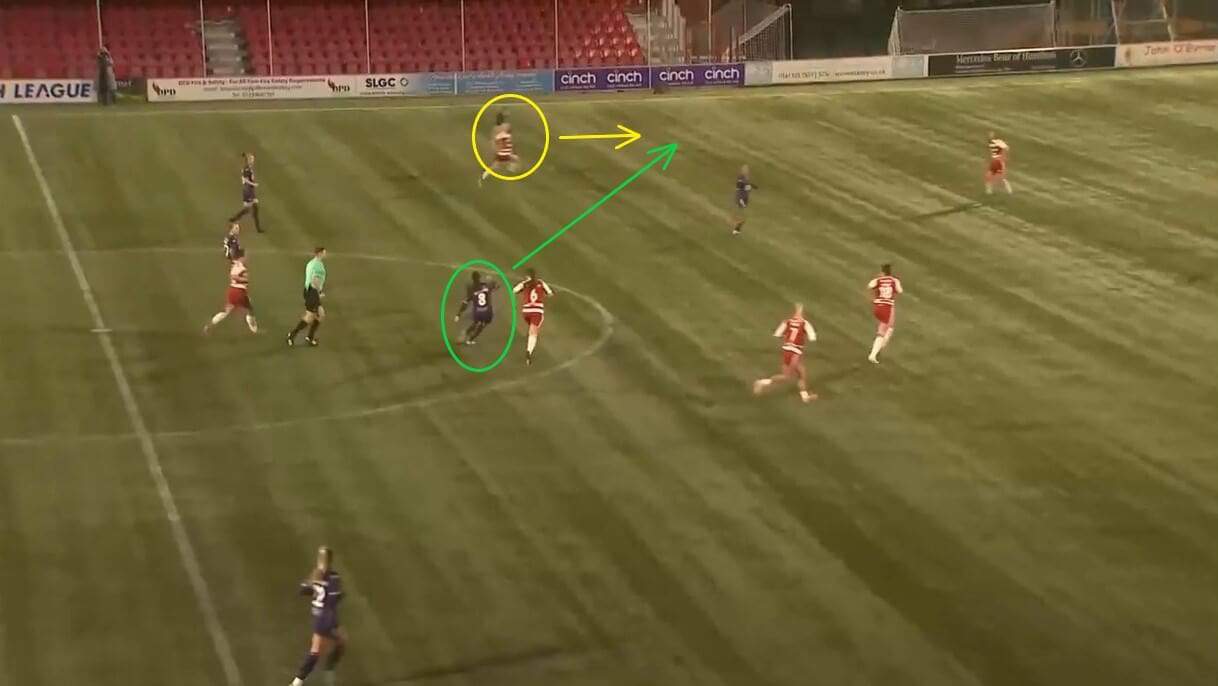
From the team’s point of view, having players who can bring that quality has been vital this season, with returning head coach Grant Scott introducing a style of play that leans heavily on wing-backs or attacking full-backs, so he needs players in the central third who can connect the dots and who can ensure that the ball is transferred around the field at a high tempo.
This is where McAlonie has, more often than not, thrived, and what really stands out is her ability to always think two or three steps ahead of those around her. In this case, she has received the ball from her back line as Hibernian launch an attack and has already noticed that left-back Shannon Leishman is making a run up the far side wing to give her a passing option. Therefore, once the ball arrives at her feet, McAlonie already knows what she will do with it and sends it towards the wing, allowing Leishman the possibility of accessing the territory behind the Hamilton Academical Women back line before they can get back into their shape.
Whilst the pass didn’t lead to anything on this occasion, the way that McAlonie demonstrated a lack of hesitation and trusted in her abilities is the crucial thing to note here, and the fact that she has a 76.8% passing accuracy so far this season shows again why she has been such an important player for Hibernian week on week when they are in transitional moments such as this.
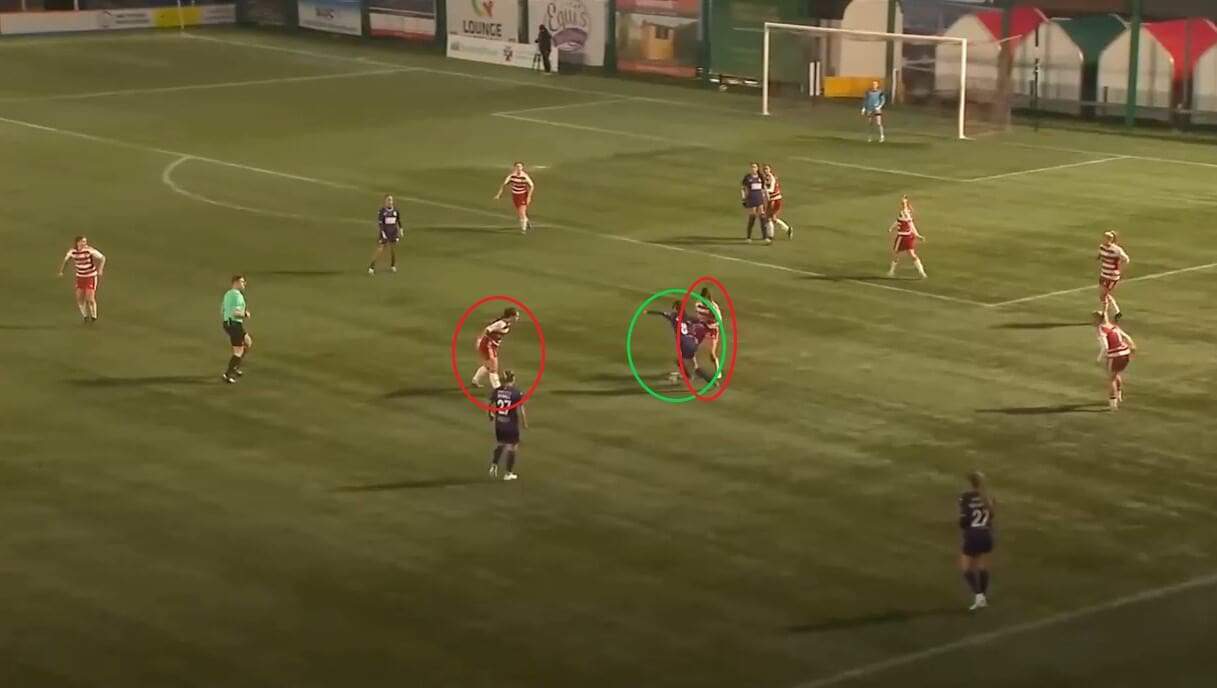
The other thing that McAlonie has shown a particular proficiency in is competing in and winning duels, with her here taking on Hamilton midfield duo Lauren Kerr and Shelley Campbell and succeeding in evading the tackle attempts of both players as she looks to set up a chance for her teammates inside the Hamilton third.
Whilst Hibernian were unable to create anything meaningful here, the fact that they have a player who likes to challenge in close-quarter battles means that they will always have a chance of moving the ball out of tight situations and of keeping attacks alive when under pressure.
It also means that they can win the ball high up the pitch whenever they aren’t in possession, and that too has been a prevalent feature of McAlonie’s play, with the weekend’s draw at Partick Thistle Women just one occasion on which her ability to press opponents from the front limited their opponents’ ability to build from the back with any great success.
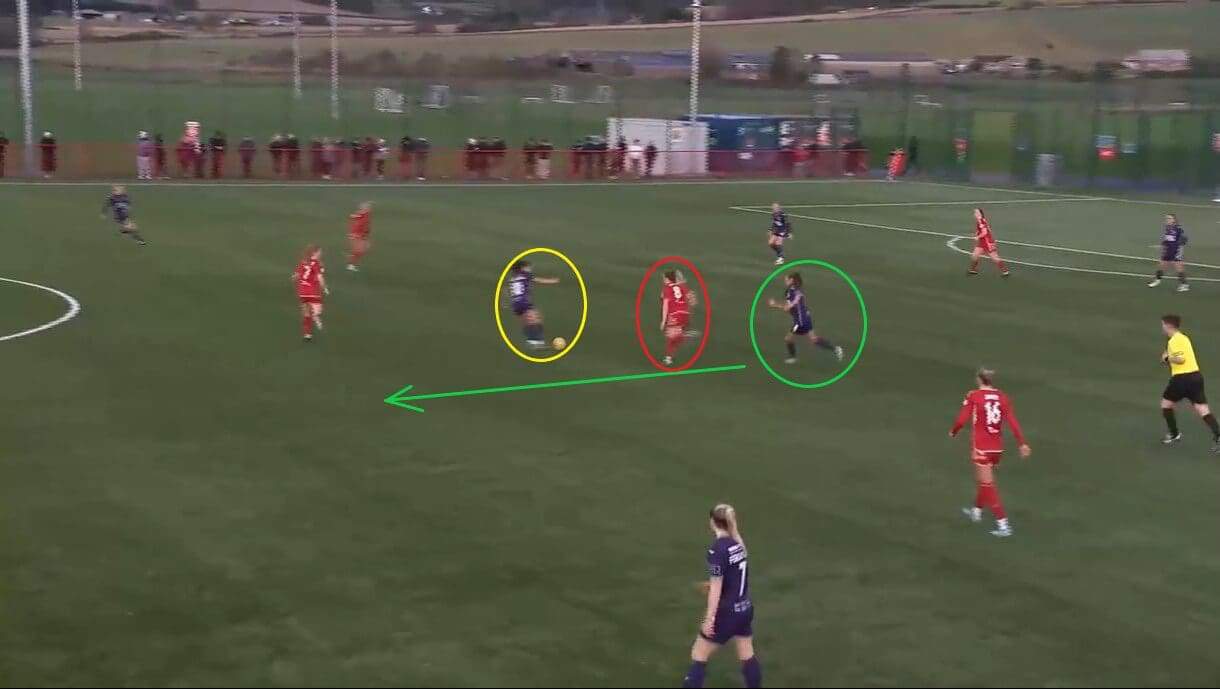
This is not to say that McAlonie succeeds in every duel, with her losing a few, too, as any player will. However, what really stands out about her is that she never dwells on those momentary lows and instead works hard to either recover or to ensure that her team can retain possession, should Hibernian have picked up the loose ball. In this situation, she lost out against Aberdeen Women’s Chloe Gover, and it would have been easy for her to slow down and to contemplate what had gone wrong, but she didn’t and instead made a run forward to ensure that when teammate Shannon McGregor turned and looked for a pass, there was one available for her to make.
Whilst Aberdeen have generally been a bottom half side since their promotion to the top flight in 2021, they are a team who are capable of making life difficult for their opponents on their day and so any opponent who leaves them space to attack into will likely see a shot on goal be conceded. Therefore, having the mentality that McAlonie showed here was crucial in stopping them from building any momentum, and that is another reason that she has been so important for them in the central third.
Supporting attacks
Whilst Michaela McAlonie is a box-to-box midfielder by trade. There is no doubt that she is at her best when in the central spaces; it is not the only area of the field that she has shone in for Hibernian Women, with her being just as effective when it comes to making the final pass or shot as she is at constructing phases of play.

It has already been mentioned that the Edinburgh side, who play their home games at Meadowbank (home to men’s Scottish League One club Edinburgh City), have leaned heavily on the use of wing-backs and attacking full-backs this season, but the other thing that Scott has introduced since his return to the team he coached to a league and cup double between 2018 and 2019 is a greater reliance on positional rotations as he tries to make them as unpredictable as possible whenever they have the ball.
As a result, players have been encouraged to move into unorthodox areas of the field and to continuously work with each other to ensure that they cannot be contained, and that is shown here by left wing-back Tegan Bowie drifting infield in her attempt to make an inverted run. On this occasion, though, she has been halted in her progress by Partick Thistle’s rearguard, with Brian Graham’s side remaining firm and organised in their attempt to keep her as far away from their goal as possible.
However, this is where McAlonie comes in, with her demonstrating the same spatial awareness that was highlighted in the previous section of this analysis to make an overlapping run and to ensure that Hibernian can keep their attack alive. It is an option that Bowie takes, and it proves to be critical in breaking Partick Thistle down, with them momentarily distracted and allowing the wing-back through to get on the end of the return pass from McAlonie.
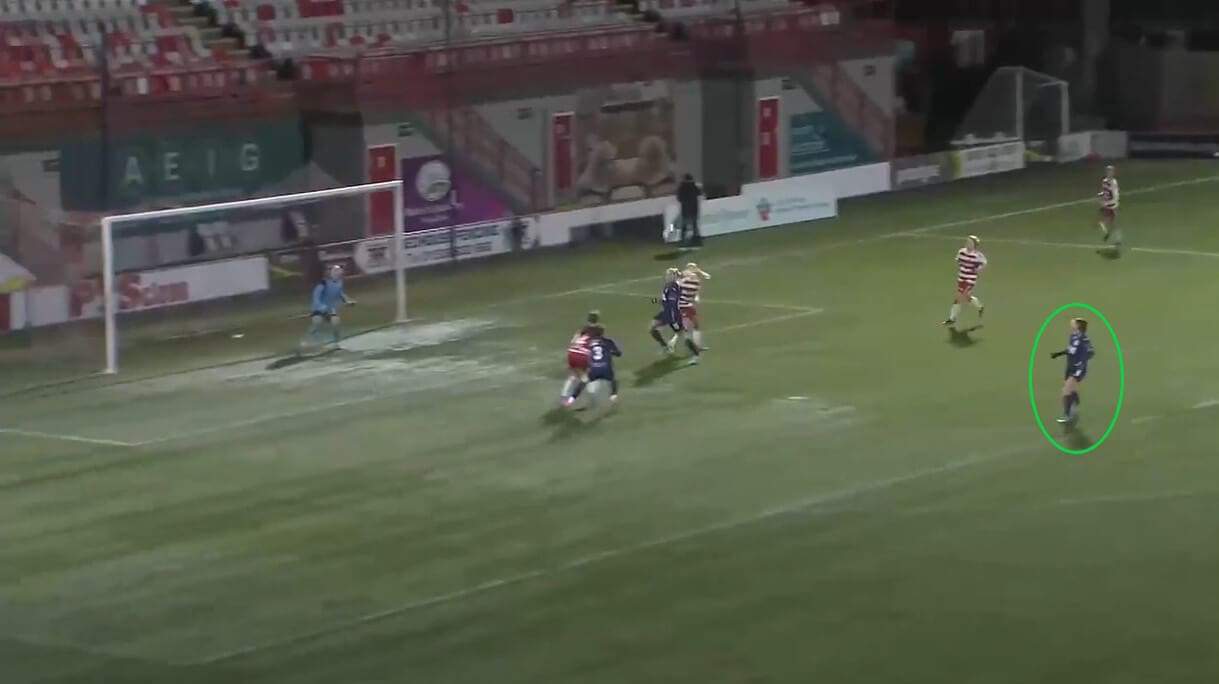
Despite the ease with which McAlonie made that run down the wing, it is not the area of the field in which she has mainly operated when inside the final third, with that being the edge of the goal area and seeing her take up positions such as this. By doing so, she has been used in almost a playmaker or a secondary attacker role, allowing her to again use her awareness to pick up loose balls, keep attacks alive, and keep linking play for her side.
On this occasion, she hung back due to forward Lia Tweedie and left-back Mya Christie offering the main target inside the Hamilton goal area. Although nothing came of this particular opportunity, it is worth noting that she has often taken up these positions when inside the final third and that it has enabled Hibernian to keep the pressure on their opponents even when initial deliveries have been cleared.

What is also interesting to note is that she has quite often taken up this role at set pieces too, and both when Hibernian are attacking and defending them. Therefore, it is clearly something that they have implemented as part of their game plan and is likely down to her speed, giving them an easy way out when inside their own third and because of her ability to react quickly to loose balls when at the other end of the field.
However, it is not only passing the ball that she looks to do from these deeper areas, and she is just as capable of shooting at goal herself, too, should the chance to do so present itself. Against Hamilton, it did, with the home side consistently leaving gaps open in their back line and inviting Scott’s side to try their luck; whilst this shot was saved by goalkeeper Chloe Nicolson, it is worth pointing out that McAlonie’s only goal this season came in this match.
Therefore, whilst her passing range has come in handy in these situations, McAlonie also offers her side a more serious goalscoring threat on occasion, and that, too, has really helped to endear her to the Hibernian fans as the years have gone by.
Defensive contributions
It has already been mentioned in the scout report that Michaela McAlonie is as effective inside her own third as she is at the top of the pitch, and that too is something that Hibernian Women have come to rely on as the campaign has gone on, with it ensuring that they can marry their fast-passing tactics in possession with a robust quality as soon as the ball has been lost.
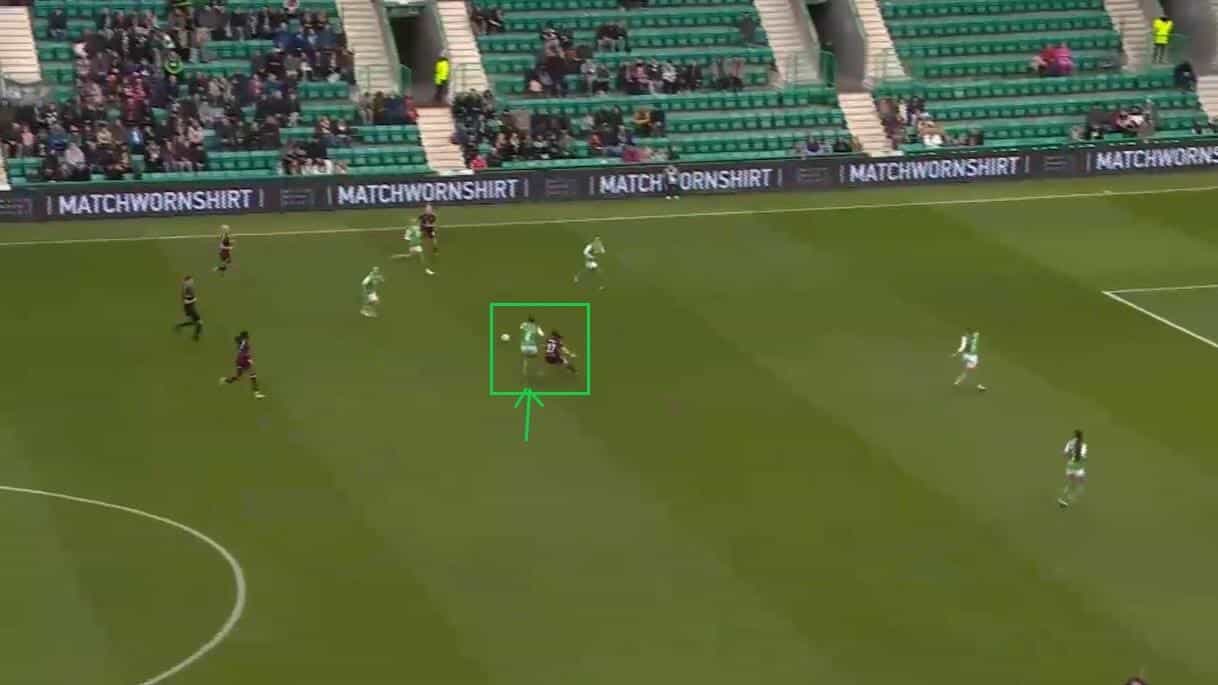
One outing in which Hibernian were especially thankful for this was the derby meeting with Hearts Women in November (which was held at the club’s main Easter Road stadium), with Eva Olid’s side known for their Spanish-influenced tactics and the fact that they play with a combination of traditional tiki-taka principles mixed with other ideas from around the world, bringing together the different experiences that Olid has come across during her time in the game.
As a result, breaking up their phases of play as early as possible was always going to be crucial if Hibernian were to win the match, and having McAlonie on the field proved to be essential in their bid to do just that, with her making 46 interceptions in total this season (an average of 3.42 per game) and winning 81.3% of her defensive duels.
In this case, she has managed to get to the inside pass towards Cailin Michie before the former Glasgow City player can control the ball, and that shows how her ability to anticipate play and to once again stay ahead of those around her has been just as vital in deeper areas as it has been when her team are looking to build their own attacks.
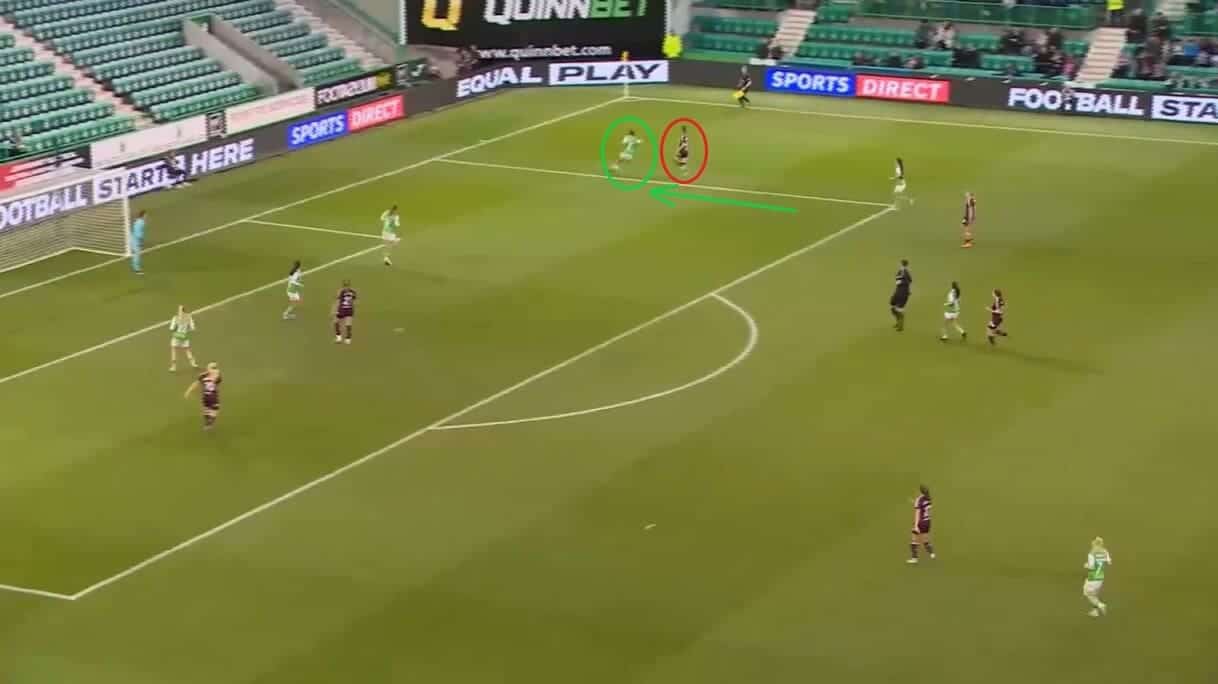
This is not to say, though, that Hibernian played a perfect game, and there were some moments when Hearts did manage to get into dangerous areas of the field. One thing that they did particularly well was to attack the spaces left open by Hibernian’s full-backs getting high up the field, just as Emma Brownlie is doing here by getting forward here and into a position from which she can deliver the ball into the middle.
For Hibernian, this presented a problem, and it did look initially as if they would need to adapt their setup to not be so front-footed. However, the presence and awareness of McAlonie meant that that wasn’t necessary in the end as she showed an ability to stay back and to protect the back line whenever they did come under pressure. In this case, she has recognised the threat that Brownlie now poses and is already moving to reach the ball before the Hearts player, and the fact that she did meant that Hibernian now had time to get back and to set their shape up ahead of the next attempt to breach their defensive line.

As this graphic indicates, it is not the only time that McAlonie has contributed to her side’s defensive efforts in this way, with her getting involved in plenty of defensive moves and interceptions inside or around her own goal area as the season has gone on, and without committing a foul in any of them.
Therefore, whilst the defensive territory that she has mainly occupied has been in the middle of the field, she is a player that Hibernian can depend on to work hard in all areas of the pitch for the team, and that too is something that any side will appreciate and which has led to her becoming such an important cog in the Hibernian machine during her almost four years at Meadowbank.
Conclusion
In conclusion, this tactical analysis has looked in detail at Hibernian Women midfielder Michaela McAlonie, highlighting the various roles that she performs around the field for her team and why they have come to rely on her in defensive, midfield and attacking situations.
Throughout the analysis, it has been made abundantly clear that McAlonie is the type of player that any team would love to have in their ranks, with her possessing a vast passing range and a strong spatial awareness and having the ability to work hard whenever her team are under pressure from opposing sides.
There are not many in the modern game who can show the same composure in every third, and that is what makes her a player deserving of more attention than she is often afforded. This may well lead to some discussing when she might be given a chance to show what she can do on the international stage. Whilst it does seem inevitable that she will feature for Scotland at some point, she is still 22 and so has plenty of time to keep growing and developing without there being too much pressure on her.
Nevertheless, she has spoken previously about getting a chance one day, and she is the type of player that Scotland could really benefit from, especially given their recent injury issues in the central third. Therefore, a first senior call-up may not be too far away.





Comments